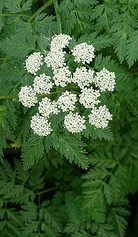 The poison hemlock, Conium maculatum, is an herbaceous biennial in the carrot family, Apiaceae that includes parsley and Queen Anne’s lace. It is not related to the evergreen, coniferous hemlock Tsuga spp. Poison hemlock grows in poorly drained soil as well as dry soil, and is found near streams and wetlands and in waste areas such as roadsides and along cultivated fields. It grows five to eight feet tall, and has a hairless, hallow stem that is usually spotted or streaked with red or purple n the low half. The small white flowers are carried in umbels four to six inches across in late spring. The leaves are twenty inches long by 16 inches wide and are pinnately compound multiple times giving the foliage a fine texture. All parts of the plant are poisonous but the strength of the poison declines as the plant dries.
The poison hemlock, Conium maculatum, is an herbaceous biennial in the carrot family, Apiaceae that includes parsley and Queen Anne’s lace. It is not related to the evergreen, coniferous hemlock Tsuga spp. Poison hemlock grows in poorly drained soil as well as dry soil, and is found near streams and wetlands and in waste areas such as roadsides and along cultivated fields. It grows five to eight feet tall, and has a hairless, hallow stem that is usually spotted or streaked with red or purple n the low half. The small white flowers are carried in umbels four to six inches across in late spring. The leaves are twenty inches long by 16 inches wide and are pinnately compound multiple times giving the foliage a fine texture. All parts of the plant are poisonous but the strength of the poison declines as the plant dries.
In King Lear (act v, sc 4, 3) Cordelia mentions the hemlock to the doctor when she describes her father who has become insane and is missing.
Crowned with rank fumiter and furrow weeds,
With burdocks, hemlock, nettles, cuckoo-flowers,
Darnel, and all the idle weeds that grow
In our sustaining corn.
The Duke of Burgundy refers to the hemlock when he addresses King Henry V of England and the King of France as he describes the war torn countryside of France. (Henry V, act v, sc 2, 44)
Her fallow leas
The darnel, hemlock, and rank fumitory
Doth root upon, while that the coulter rusts
That should deracinate such savagery.
As the witches mix up their brew in Macbeth, ( act iv, sc, 1, 25) The Third Witch adds
Root of Hemlock
Digg’d i’ the dark.
Poison hemlock has been known from ancient times and was used by the Athenian government to execute people condemned to death for state crimes. The most famous case was that of Socrates described by Plato. The generic name, Conium, comes from the Greek, knas, meaning to whirl, referring to the vertigo that is caused when the plant is ingested. The specific name, maculatum, means spotted and refers to the appearance of the stem